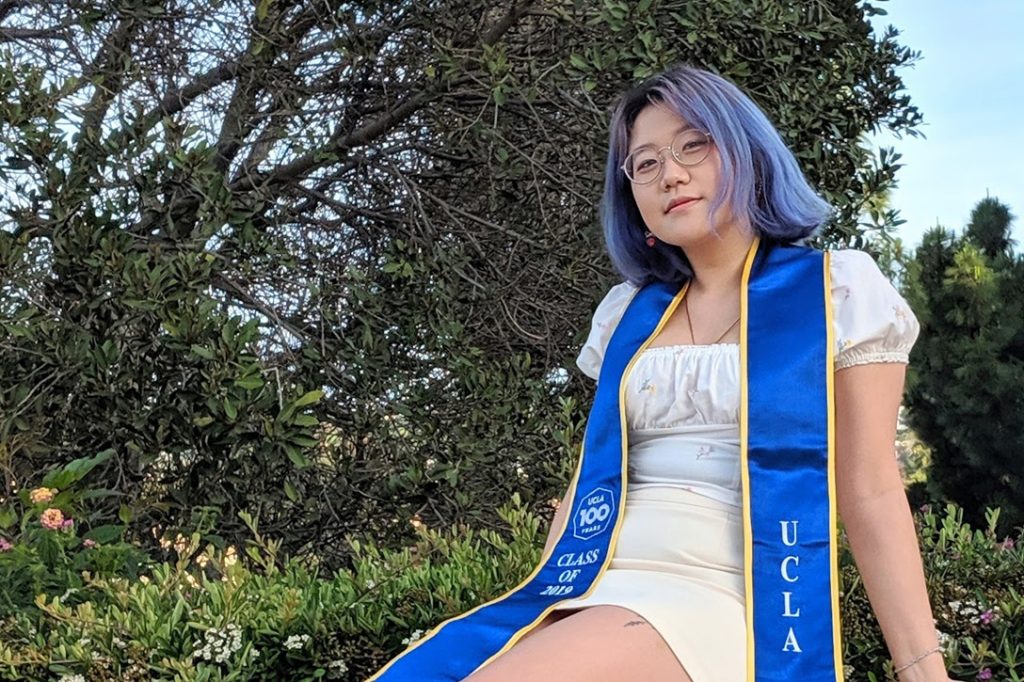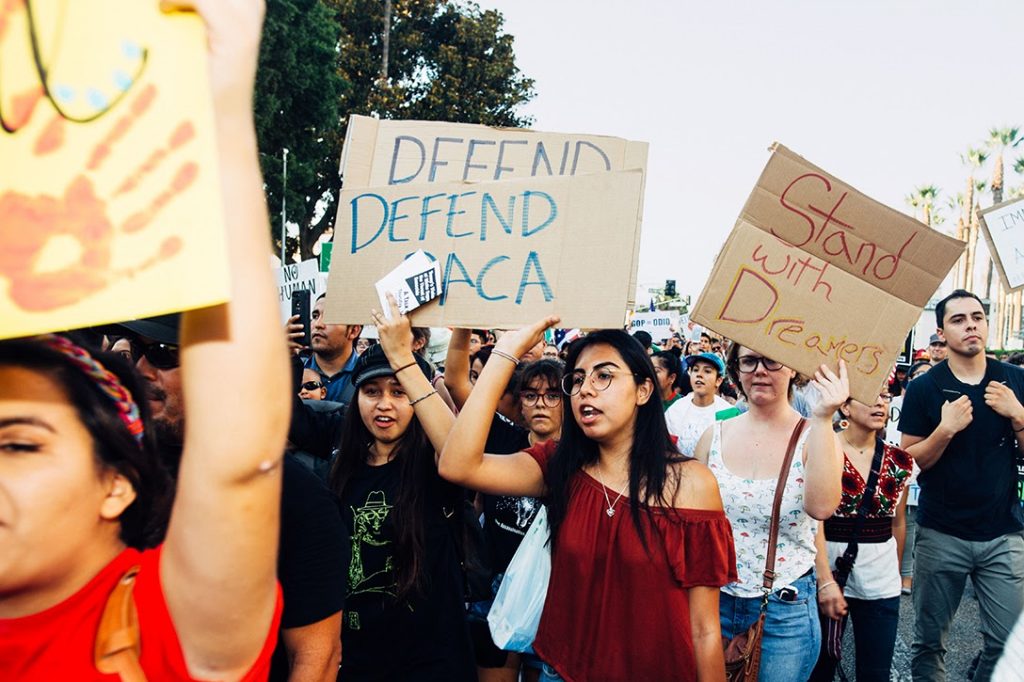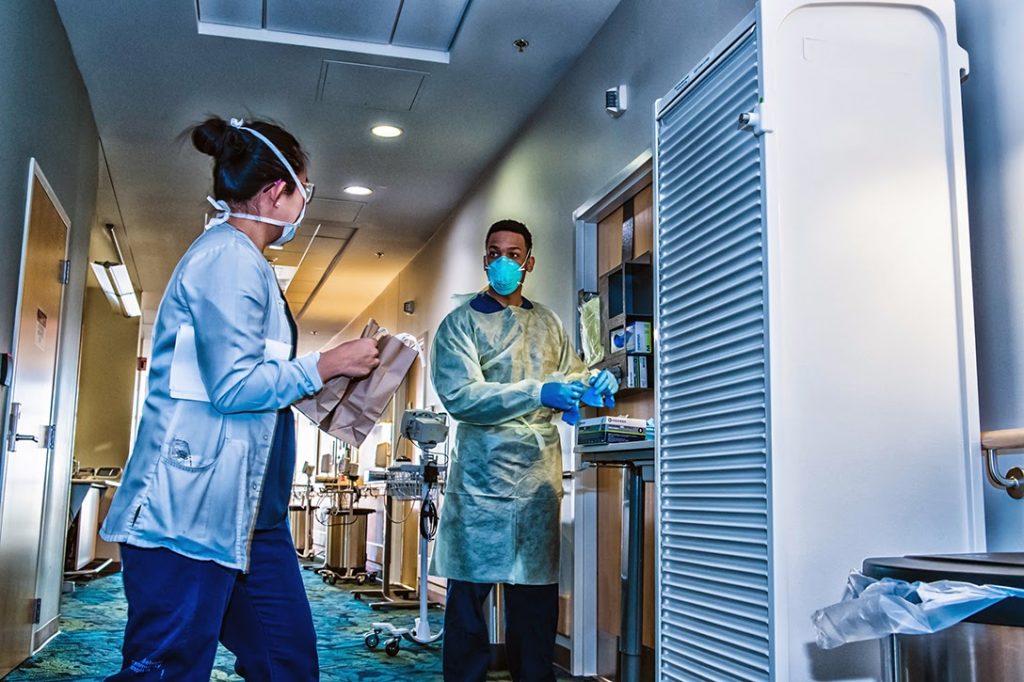Undocumented students face greater challenges than ever in their pursuit of postsecondary education.
This story is part of our ongoing series, Tested, which examines the challenges and opportunities the coronavirus pandemic poses for the US education system on all levels.
The US Supreme Court’s rejection of President Donald Trump’s attempt to repeal the Deferred Action for Childhood Arrivals Program, better known as DACA, sent audible sighs of relief rippling through the nation last June.The relief was temporary, however. Thousands of DACA recipients, along with many undocumented students, still have plenty of reason to be fearful when applying to colleges this year.
Undocumented youth, sometimes called “DREAMers” in reference to the pending Development, Relief, and Education for Alien Minors (DREAM) Act in Congress, face steep challenges when it comes to paying for the total cost of attending college. COVID-19 is just the latest in a long series of obstacles.
Angela Laureano is a typical DACA student. She and her family moved from Mexico when she was three years old, settling into a low income community near downtown Los Angeles. Like many of her peers, Laureano devoted much of her early education to working alongside her family. In order to afford college, she worked 28 hours a week as a waitress, cashier, and janitor at a small diner throughout her senior year of high school.
“I come from a long lineage of poverty,” she said. “Before my great-grandma passed, she told me that she was dirt poor. At the time, I honestly didn’t have the social capital to even explain what I wanted for my future.”
The hardship she experienced played out against a backdrop of domestic politics, as Congress grappled with the merits and consequences of supporting the nation’s immigrant population. Without financial aid and support from her fellow immigrants, Laureano might not have been able to achieve her dream of attending college. Thousands of students face similar situations. Now, Laureano is preparing for her upcoming year at UC Berkeley where she is majoring in African American studies and public policy. Her long-term goals are to work in criminal justice policy or advocacy, largely because of the impact that mass incarceration has had on her community and the people she loves.
As the economy encounters turbulence, budget cuts to postsecondary education across the nation have affected financially unstable students in general. Undocumented students have the most to lose. According to the 2019 SHEEO State Higher Education Finance report, state funding for higher education often faces greater cuts than other budget areas.
The high rates of unemployment and financial uncertainty that are increasingly rampant throughout the nation have left colleges and universities strapped for funds. More importantly, it has hurt the “best and the brightest of our young generation,” said Victor Narro, a professor for the Labor and Workplace Studies Program at UCLA.
The promise of an American education remains a major incentive that lures immigrant families who seek new opportunities to the US.
In a recent survey of dozens of community-based organizations, higher education representatives, students, and immigrant and civil rights organizations conducted and provided to WhoWhatWhy by The Campaign for College Opportunity, more than 80 percent cited financial loss as an undocumented student’s greatest challenge during COVID-19, said Linda Vazquez, the organization’s senior public affairs director. Higher than 90 percent said that a parent or family member had lost their primary means of income, and 57 percent struggled themselves with a loss of student housing and rental leases.
A History of Exclusion
Due to Plyler v. Doe, a 1982 US Supreme Court decision, states are not required to educate undocumented students beyond high school. Nevertheless, the promise of an American education remains a major incentive that lures immigrant families who seek new opportunities to the US.
Since the late 1900s, the number of immigrant students attending college has increased substantially. Immigrants now account for 2 percent of all students in higher education, or roughly 454,000 students, according to the Presidents’ Alliance on Higher Education and Immigration and New American Economy (NEA).
Despite this evolution, the majority of postsecondary educators have been left without adequate strategies or the tools needed to support such a diverse immigrant student body. Stripped of external support networks, the shutdown has trapped many immigrant college students in a silo of uncertainty and confusion.
More important, institutional passivity begins well before the postsecondary level. The stigma and shame long attached to undocumented, low-income students doesn’t dissipate as a student leaves high school; rather it expands to include new college experiences that can be just as frightening.
Lyra Kim, a recent graduate from UCLA, where she majored in political science and Asian American Studies, faced a lack of understanding from university personnel who were supposed to support her. “A lot of school staff were not knowledgable about the undocumented experience,” Kim explained. “Nobody really knew how to help me. The exceptions were other undocumented people and students.”

Lyra Kim. Photo credit: Courtesy of Lyra Kim
As with many undocumented students, Kim’s high school years passed in a whirlwind of confusion and uncertainty. With only inept counselors and a fragile community of other undocumented students to turn to, Kim found that she could not depend on school for support and had to fend for herself.
“I felt stuck and really tired most of the time,” she recalled. “I didn’t know how the college process worked for undocumented [students] or how to apply for financial aid. My counselors didn’t know anything, and my mom, who is also undocumented, didn’t know anything either,” said Kim. “I had to accumulate knowledge on how to navigate high school and college on my own and then educate my counselors in high school and in college. Still, sometimes it felt like I was talking to people who didn’t see me as someone worth helping.”
A Lack of Federal Aid and the State Response
Undocumented students are already excluded from receiving federal financial aid such as Federal Pell Grants, Federal Work-Study, and Federal Direct Student Loans (Direct Loans). Many private colleges and universities classify undocumented and DACA applicants as international students, which significantly reduces their access to institutional financial aid.
The recent $2 trillion Coronavirus Aid, Relief, and Economic Security (CARES) Act attracted attention when Education Secretary Betsy DeVos announced that higher education emergency funds would go to eligible US residents, but would be barred from supporting tens of thousands of DACA and undocumented students in need of emergency financial aid.
Democrats vehemently denied that the act should be interpreted as excluding DACA students, and advocacy groups rallied to defend accessible postsecondary education, dredging up the history of past discrimination and injustice. Besides hurting DACA students, the decision threatened to send many institutions, including community colleges, which enroll low-income students who had previously not needed to apply for aid because of tuition waivers, into a debt spiral.
As soon as the district-wide transition to online learning went into effect, Pamela Ortiz Cerda, the Dream Center program services coordinator at Skyline Community College in San Bruno, CA, began scheduling one-on-one sessions with each undocumented student in order to provide financial aid updates in addition to those outlined in their weekly newsletters. Cerda, an undocumented college student herself, was relieved to learn that the center was able to raise money independently.
“Emergency grants and financial aid are not just important in times like this shutdown and COVID-19,” she said. “Undocumented students can face so many different emergencies like family detention, or the need for additional support if they are the breadwinner in the family. I think other great programs are service scholarships, because a student without DACA cannot legally work and that limits them from a lot of professional development opportunities.”
“What we are seeing is a lack of compassion, but it is also a very short-sighted decision that denies [undocumented] students the emergency aid they need.”
Many Dream resource centers like the one at Texas Tech University (TTU) have had to physically close or turn to online websites in the wake of the shutdown. Like many universities, TTU has had to depend on private donations to fund their financial aid relief programs.
“If we had a student without internet access we would talk with the student via phone to collect necessary information,” Elizabeth Massengale, Ph.D., an assistant dean of students and managing director of Parent and Family Relations at TTU, told WhoWhatWhy. “The [Raider Relief Program] has grown from only providing financial support to now connecting students with other resources on and off campus. Additionally, we have a team within the Office of the Dean of Students, Graduate School, and Office of International Affairs that can reach out to students in need and offer assistance and support.”
Mark Kantrowitz, publisher and vice president of research for Savingforcollege.com, said that the policies reflect the “spite and prejudice” the current administration holds against immigrants.
“The reality is that the virus doesn’t discriminate; the emergency grants discriminate. If Congress had wanted to restrict the emergency financial aid grants to US citizens and permanent residents, they would have done so explicitly because they did so elsewhere in the law,” Kantrowitz told WhoWhatWhy. “What we are seeing is a lack of compassion, but it is also a very short-sighted decision that denies [undocumented] students the emergency aid they need.”
Legislation granting undocumented students in-state tuition rates gives them an incentive for completing high school, attending college, and eventually contributing to a state’s society and economy. Given that postsecondary options for undocumented students are severely limited, the financial aid options that are available are of even greater value.
The National Association for Student Financial Aid Administrators notes that the most common criteria that qualifies undocumented students to receive in-state tuition include: attending a state high school for two to four years, earning a high school diploma or General Education Diploma (GED) in the state, enrolling in a public postsecondary institution in the state, and filing an affidavit stating intent to legalize status and become a permanent resident.
Three states — Arizona, Georgia, and Indiana — specifically prohibit in-state tuition rates for undocumented students, and two states — Alabama and South Carolina — prohibit undocumented students from enrolling at any public postsecondary institution. A growing number of states, including California, Washington, and Texas, tend to be more favorable to their undocumented and DACA college students and have instituted legislation allowing students to be exempt from certain eligibility barriers.

Protest supporting DACA in Los Angeles on September 5, 2017. Photo credit: Molly Adams / Flickr (CC BY 2.0)
For example, in 2001 California passed Assembly Bill 540 for students who are undocumented or a US Citizen/Permanent Resident who went to high school in California. It creates a specific checklist of requirements, including attending a California public institution of higher education, and, once fulfilled, allows students to pay “resident fees” instead of “non-resident fees.”
Nevertheless, when states do hand out financial aid, immigrant students typically get the smallest, leftover pieces of that pie.
“You have more students eligible than funding for the grants,” Vazquez explained, “so if there is money left over, then undocumented students are given consideration.”
Indeed, without federal help, there is a limit to how much an institution can help its undocumented students with or without DACA.
“Because I didn’t have DACA, things that would provide me with actual security like a job and financial support, were limited for me,” said Kim. “During community college I worked off campus a lot. I often thought about how tempting it would be to quit school. It was really hard to be a student while feeling as if I were stuck working at a minimum wage job for the rest of my life.”
Fear of Deportation
As the economy dips into deeper turbulence and many colleges revert to online classes, undocumented college students without internet access are often left stranded. For recently graduated seniors, social distancing makes it harder to connect with counselors or outside resources to ask for help about the financial aid process. All these worries create a volley of twists and turns as students without DACA also have to grapple with the fear of being deported.
Legally, school officials are not allowed to report undocumented parents and children to US Immigration and Customs Enforcement (ICE) or US Citizenship and Immigration Services (USCIS) without facing lawsuits and liabilities against both school districts and school officials.

Students are struggling to do work from home. Photo credit: Nenad Stojkovic / Flickr (CC BY 2.0)
However, under the Family Educational Rights and Privacy Act (FERPA), a school or school district may disclose information from an undocumented student’s education records without their consent to specific entities, such as a state education office, or for specific purposes, such as to comply with a court order.
“I do not believe the threat of being reported ever went away by going from physical schools to virtual learning,” said David Hinojosa, director of the Educational Opportunities Project at the Lawyers’ Committee for Civil Rights Under Law. “People’s own spite and prejudices against immigrant families and children is fueled by hateful rhetoric in politics and [the] media. That continues everyday on certain news channels and outlets, as well as social media and private emails.”
“It’s always been a fear [that] I’ve had,” Kim agreed. “Honestly, I would say that a fear of indefinite detention is almost stronger than my fear of deportation. The power that ICE has when they detain you is really scary and speaking as a woman, the possibility of assault and harassment is much higher.”
As a response to these worries, student legal centers, which provide legal advice, counsel, and limited representation to immigrant students, have started to pop up in colleges across the nation.
According to Denzil Mohammed, director at the Immigrant Learning Center (ILC) Public Education Institute, besides legal centers within a college, a lot of money is being funneled from the private sector to legal defense funds, representation funds, and DACA recipients.
“Especially now that we are in the Trump era, legal centers are unprecedentedly important. There’s a lot of uncertainty, and knowledge of legal recourse and legal pathways [has] never been more important for DACA recipients. Legal assurance is one of the most meaningful and reassuring things for immigrants, and I can tell you that from personal experience,” said Mohammed.
“I am scared of getting COVID-19 and trying to stay at home as much as I can, but I still have to pay my bills and taxes.”
Undermining Faith in the American Dream
If anyone ever doubted that inequality of opportunity exists in our nation, this pandemic has proved it. The American Dream, the idea that opportunities are granted to those who work hard, is severely incompatible with the inequality in education that this country perpetuates.
Whether they are considered the best and brightest of our generation or a futile waste of time and resources, these students often find their opportunities limited by societal and family expectations.
Undocumented students who have no choice but to abandon their college dreams often land in low-wage jobs and are taken advantage of by their employers.
On the other hand, undocumented students are even further devalued by the pressure of living out the “good immigrant narrative,” the expectation that each student will grow up to be a poster child that surpasses their parents’ potential with a college degree to match. Society continues to promote this expectation, even as the pandemic rages on, without considering the stress it imposes on many undocumented students like Laureano, who must adjust to distance learning while battling COVID-19.
“This past semester has been unstable for me. My family also got COVID-19, so I’ve been taking care of people while also doing my Public Policy International Affairs program and attending other meetings here and there for programs that carried into the summer because they were disrupted in the Spring. When I’m sick I still usually work but this time I just couldn’t, I felt so nauseous,” said Laureano. “The good immigrant narrative is degrading because I just do what I have to do to survive. I wasn’t aware of my status until I turned sixteen, but I knew I had to be extra perfect, not get into trouble, and do everything right.”
How This Will Hinder America’s Recovery From COVID-19
Amid the rising unemployment claims tied to COVID-19, the value that highly educated immigrants add to our economy has never been greater.
Immigration has an overall positive impact on long-term economic growth in the US, as second generation immigrants are among the strongest contributors to the US economy, a 2017 report from The National Academies of Sciences, Engineering, Medicine concluded. The shutdown has proven that as more Baby Boomers retire, students leaving the college-to-labor-force pipeline will provide for them as their doctors, nurses, and home health aides, among other essential professions.

Team members at Fort Belvoir Community Hospital in Virginia prepare for the start of a new day admitting and caring for patients with COVID-19 on April 20, 2020. Photo credit: Fort Belvoir Community Hospital / Flickr (CC BY-NC 2.0)
Working on the frontlines of the pandemic is not a strange experience for many undocumented students, as they were often forced to work essential jobs before the pandemic in order to afford their education.
Elias Geronimo immigrated from Guatemala 13 years ago and is now pursuing a biology major during his third year in community college. He is hoping to transfer to a four-year university this semester, but he isn’t sure how his fall classes will correlate with his daytime job at a supermarket.
“My goal is to get a job in the medical field. But now I am struggling because most students like myself live without their parents in the US. I think that if I continue working at the supermarket, I would have to take my classes at night. I am scared of getting COVID-19 and trying to stay at home as much as I can, but I still have to pay my bills and taxes.”
Moreover, immigrants tend to work in jobs that are disproportionately on the high and low ends of the skill spectrum. On one hand they may concentrate as maids and cleaners, and on the other, as physicians and life science researchers. According to data compiled by New American Economy, in 2018 undocumented immigrants in entrepreneurial fields generated $15.2 billion in business income.
Geronimo notes that the transition from in-classroom to online learning hasn’t been easy, especially because all of his science classes have had to move their labs online. However, he is excited that he is still on a pathway towards fulfilling his postgraduate plans, which involve going to medical school.
“Even after the pandemic, I will stick with my plan to become a medical doctor. My goal is to help people, and if there is an opportunity to save lives I will be there. Most doctors didn’t know that we would be in a pandemic, but here we are now,” said Geronimo.
However, even those that have succeeded in obtaining a degree are struggling to find work amid this pandemic.
Has Trump Backer and Education Czar Betsy DeVos Gone Too Far?
Kim counts herself lucky to have found a job, but believes the undocumented community she found at her university played a larger role in her success than her college degree.
“I got a job at a community organization as an organizer, and I am really fortunate to be able to work through the pandemic,” she said. “What was really crucial was to find other undocumented people.”
According to the Center For American Progress, 97 percent of DACA recipients are employed or currently in school and are set to contribute $460 billion to the US economy in the next decade. Policymakers may be forced to rethink how they view undocumented students, who play an essential role in the functioning of their economies.
“Supporting them and their higher education journey is not only morally imperative but an investment to strengthen our workforce and economy,” said Vazquez. “They are going to be our future doctors, lawyers, and teachers. If we are not investing in them, especially during these hard times, our economic future will be grim.”
School used to be society’s equalizer, but with education budget cuts around the nation, navigating the transition from college to career and finding the money to finance a postsecondary education has become difficult. Immigration remains a polarizing issue; yet amid a national debate knotted with anti-immigrant rhetoric and policies, there has yet to be a pause to consider where immigrants fall in our education system.
Whether saddled with onerous debt or unable to afford a higher education at all, the racially and economically diverse student body in America will continue to grow as the pandemic rages on.
“School is one of the safest places for undocumented students. Being a university student and being undocumented is very different than being undocumented out there without resources and support,” Laureano said. ”Unfortunately we live in a society that values people based on where they go to school rather than their own humanity.”
Rani Chor is a high school journalist from California and an apprentice in WhoWhatWhy’s Mentor-Apprentice Program, whose goal is to help train the next generation of journalists. For more information on participating as a mentor or apprentice, or if you would like to support our work, please contact us.
Related front page panorama photo credit: Adapted by WhoWhatWhy from Molly Adams / Flickr (CC BY 2.0), Molly Adams / Flickr (CC BY 2.0), and Molly Adams / Flickr (CC BY 2.0).



